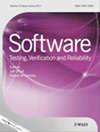RATE:一种基于模型的测试方法,结合了模型细化和测试执行
IF 1.2
4区 计算机科学
Q3 COMPUTER SCIENCE, SOFTWARE ENGINEERING
引用次数: 0
摘要
在本文中,我们提出了一种基于抽象状态机(asm)的一致性测试方法,该方法结合了模型优化和测试执行(RATE),并将其应用于三个案例研究。RATE方法包括从asm生成测试序列,并在多个迭代中检查代码和模型之间的一致性。该过程遵循以下步骤:(1)将系统建模为抽象状态机;(2)对模型进行验证和验证;(3)根据ASM模型自动生成测试序列;(4)对实现执行测试,计算代码覆盖率;(5)如果覆盖率低于期望的阈值,则细化抽象状态机模型以添加未覆盖的功能并返回步骤2。我们在三个案例研究中应用了该方法:交通信号灯控制系统(TLCS)、IEEE 11073‐20601个人健康设备(PHD)协议和米兰机械呼吸机(MVM)。通过在每个细化级别上应用RATE,我们增加了代码覆盖率,并为所有案例研究确定了一些错误或一致性错误。突变分析也证实了RATE的故障检测能力,其中我们强调,即使是最抽象的模型也可以杀死许多突变体。本文章由计算机程序翻译,如有差异,请以英文原文为准。

RATE: A model‐based testing approach that combines model refinement and test execution
In this paper, we present an approach to conformance testing based on abstract state machines (ASMs) that combines model refinement and test execution (RATE) and its application to three case studies. The RATE approach consists in generating test sequences from ASMs and checking the conformance between code and models in multiple iterations. The process follows these steps: (1) model the system as an abstract state machine; (2) validate and verify the model; (3) generate test sequences automatically from the ASM model; (4) execute the tests over the implementation and compute the code coverage; (5) if the coverage is below the desired threshold, then refine the abstract state machine model to add the uncovered functionalities and return to step 2. We have applied the proposed approach in three case studies: a traffic light control system (TLCS), the IEEE 11073‐20601 personal health device (PHD) protocol, and the mechanical ventilator Milano (MVM). By applying RATE, at each refinement level, we have increased code coverage and identified some faults or conformance errors for all the case studies. The fault detection capability of RATE has also been confirmed by mutation analysis, in which we have highlighted that, many mutants can be killed even by the most abstract models.
求助全文
通过发布文献求助,成功后即可免费获取论文全文。
去求助
来源期刊

Software Testing Verification & Reliability
工程技术-计算机:软件工程
CiteScore
3.70
自引率
0.00%
发文量
34
审稿时长
>12 weeks
期刊介绍:
The journal is the premier outlet for research results on the subjects of testing, verification and reliability. Readers will find useful research on issues pertaining to building better software and evaluating it.
The journal is unique in its emphasis on theoretical foundations and applications to real-world software development. The balance of theory, empirical work, and practical applications provide readers with better techniques for testing, verifying and improving the reliability of software.
The journal targets researchers, practitioners, educators and students that have a vested interest in results generated by high-quality testing, verification and reliability modeling and evaluation of software. Topics of special interest include, but are not limited to:
-New criteria for software testing and verification
-Application of existing software testing and verification techniques to new types of software, including web applications, web services, embedded software, aspect-oriented software, and software architectures
-Model based testing
-Formal verification techniques such as model-checking
-Comparison of testing and verification techniques
-Measurement of and metrics for testing, verification and reliability
-Industrial experience with cutting edge techniques
-Descriptions and evaluations of commercial and open-source software testing tools
-Reliability modeling, measurement and application
-Testing and verification of software security
-Automated test data generation
-Process issues and methods
-Non-functional testing
 求助内容:
求助内容: 应助结果提醒方式:
应助结果提醒方式:


